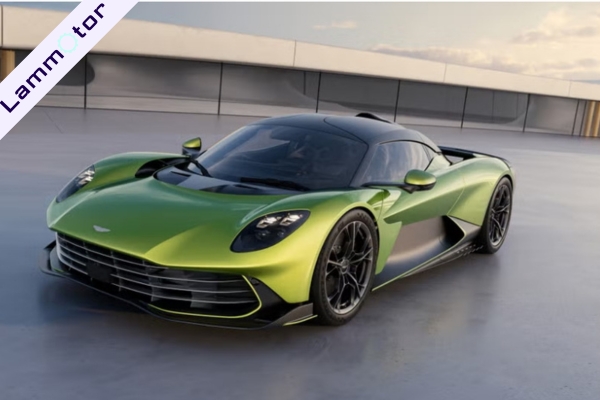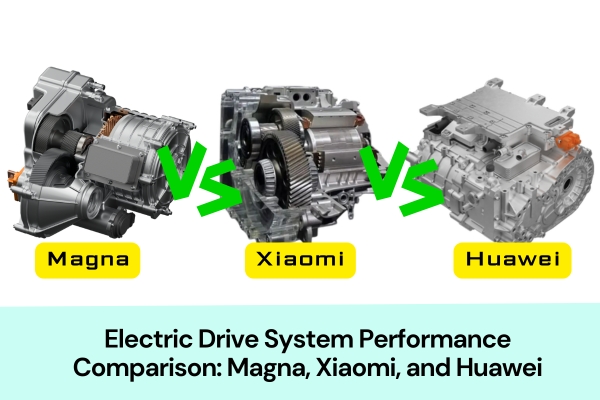Many luxury car brands see the axial flux motor as the best solution for electrification. But do you know which car models are already using it?
The axial flux motor is known for its high power density, compact size, and fast response. Compared to traditional radial flux motors, it has shorter magnetic paths, higher torque output, and better cooling performance. These features make the axial flux motor perfect for high-end electric vehicles that demand top performance.
Now let’s take a look at some well-known models that use axial flux motors.
Ferrari SF90 Stradale
The SF90 Stradale is Ferrari’s first model to use a PHEV (plug-in hybrid electric vehicle) system. This system combines a traditional internal combustion engine with three electric motors. Two of them are independent and mounted on the front axle. The third is a YASA axial flux motor, located at the rear between the engine and the transmission.

Front Motors: three-phase permanent magnet synchronous motors
According to Ferrari, each front motor weighs only 12 kilograms and follows a fairly traditional design. These are three-phase permanent magnet synchronous motors with a cylindrical shape, which is typical for radial flux motors. They can reach speeds up to 25,000 rpm and are made by Magneti Marelli, a well-known Italian parts supplier.
Each front motor delivers a peak power of 99 kW and a peak torque of 85 Nm. However, the SF90 Stradale’s third motor at the rear easily exceeds those numbers.
The rear motor: axial flux motor

A YASA axial flux motor produces up to 150 kW of peak power and 266 Nm of torque.
This three-phase axial flux motor is more powerful and efficient, making it a key part of the car’s high-performance hybrid setup.
Lamborghini Temerario

The Temerario is the second model in Lamborghini’s High Performance Electrified Vehicle (HPEV) series, coming after the Revuelto. It is equipped with a hybrid system that uses a twin-turbocharged V8 engine.
This brand-new hybrid system combines the all-new twin-turbo V8 engine with three YASA motors, pushing the total system output to over 900 horsepower. The integration of axial flux motors gives the car both lightweight construction and fast power delivery.
Two of these axial flux motors are installed on the front axle of the Temerario. Each motor delivers a peak torque of 300 Nm and a peak power of 110 kW. Despite this strong performance, each motor weighs only around 17 kilograms, helping to reduce the car’s overall weight and improve handling. Thanks to the compact size and flat structure of the axial flux motor, Lamborghini was able to design a lower and more aerodynamic front end.
The third axial flux motor is mounted between the V8 engine and the transmission at the rear. It assists the combustion engine and helps distribute power more efficiently. This setup not only improves acceleration and responsiveness but also contributes to better overall energy efficiency.

By using three axial flux motors, the Temerario shows how Lamborghini is combining extreme performance with cutting-edge electrification. These motors allow for precise torque vectoring, improved traction, and sharper cornering—all without sacrificing the aggressive driving style the brand is known for.
McLaren Artura
The Artura is equipped with a brand-new twin-turbo V6 engine and an axial flux motor, paired with an 8-speed transmission and a lithium-ion battery pack. It delivers a maximum power of 680 horsepower and 720 Nm of torque. The car can accelerate from 0 to 100 km/h in just 3 seconds, and from 0 to 300 km/h in only 21.5 seconds.
The axial flux motor works together with the V6 engine to provide quick response and strong power output.

The axial flux motor in the Artura weighs only 15.4 kilograms. It is housed inside the transmission bell housing and is about the size of a small frying pan.
Mercedes-Benz Vision One-Eleven

The Mercedes-Benz Vision One-Eleven concept car is equipped with YASA’s unique axial flux motor.
It features four drive motors, each capable of producing 480 horsepower, giving the car a total output of 1,920 horsepower.
This model uses YASA’s axial flux motor, which has only one-third the depth of a radial flux motor. With fewer components, its weight is also cut down to one-third. More importantly, each of these compact motors can generate 480 horsepower — 145 more than similar motors developed by Koenigsegg.

The use of the axial flux motor not only improves power-to-weight ratio, but also makes it possible to achieve a more compact and efficient design. It plays a key role in the performance and innovation of the Vision One-Eleven concept.
Aston Martin Valhalla

The Aston Martin Valhalla, as a flagship supercar, boasts incredible power figures. It is powered by a 4.0L twin-turbo V8 engine paired with three electric motors, forming a plug-in hybrid system. The total system output can reach 1,079 horsepower, with the engine alone producing 828 horsepower. One of the electric motors is integrated into the 8-speed dual-clutch transmission, while the other two are mounted on the front axle.
The Valhalla’s powertrain is centered around a newly developed flat-plane crank V8 twin-turbo engine. This power unit carries over technology from Mercedes-AMG’s high-performance models and, after special tuning, achieves an output of 817 horsepower. The drivetrain also incorporates an axial flux motor module, combining both starter and generator functions.
In addition, the Valhalla’s front axle is equipped with a dual permanent magnet synchronous motor setup, creating an electronic all-wheel-drive system with a total output of 248 horsepower.
Koenigsegg Gemera
The Koenigsegg Gemera is powered by a 5.0L V8 twin-turbo engine combined with an axial flux motor. Koenigsegg has named this axial flux motor the “Dark Matter Motor,” which is a hybrid between radial and axial motors.

The single motor produces 600 kW (800 horsepower) and 1,250 Nm of torque. When paired with the engine, the total output of the vehicle reaches an impressive 2,300 horsepower.
The “Dark Matter” motor is not actually related to dark matter. It is essentially a permanent magnet synchronous motor, but its internal structure is quite different from traditional motors. By combining the advantages of both radial and axial flux motors, it achieves high power density and efficient heat dissipation.
VOYAH

VOYAH Motors has successfully overcome 13 major technical challenges to develop China’s first axial flux motor for passenger vehicles.
The single motor delivers a peak torque of 680 Nm, making it the world’s first motor of its kind with this level of performance.

In addition to its outstanding performance, the VOYAH axial flux motor also offers multiple advantages, including lightweight, compact size, and high efficiency. This innovative technology fills a gap in China’s passenger vehicle market for axial flux motors and breaks through international technical barriers, marking a new milestone for China’s high-performance motor technology.
How does the Axial Flux Motor Work in Fully Electric Cars?
As more automakers seek differentiation and performance leadership in the era of electrification, the attention and market applications of axial flux motors in fully electric vehicles (EVs) are growing rapidly. Companies like Chery, Xiaomi, Geely, BYD, and Huawei are all exploring this technology.
Mercedes-Benz has even announced that in 2025, it will release a model featuring YASA’s axial flux motor, which will be the first high-performance fully electric car to use this type of motor.
Currently, there are two main drive systems for axial flux motors in fully electric cars:
Hub Distributed Drive:

This system directly places the motor inside the wheel, allowing for independent control of each wheel’s power output. This improves vehicle handling and stability. The small size and lightweight nature of the axial flux motor make it an ideal choice, as it helps reduce unsprung mass, enhancing ride comfort.
Central Distributed Drive:

In this setup, two drive motors are placed opposite each other on the frame, connected to the wheels by longer half shafts. This design not only increases the system’s rigidity but also boosts transmission efficiency. The flat design of the axial flux motor is especially suited for this configuration, as it provides enough power and torque within a compact space.
The 2025 Shanghai Auto Show showcased significant advancements in axial flux motor technology, highlighting their growing adoption in the automotive industry. Notable developments included:
Valeo: Introduced a compact and efficient axial flux generator, achieving up to 97% efficiency and a 50% reduction in size. They announced a collaboration with Pangood Power to accelerate the development of next-generation electrification solutions.
Pangood Power: Unveiled the ICD306K motor, delivering 306kW peak power at 18,000 rpm, with a power density exceeding 21kW/kg. Their dual-motor system offers 612kW peak power within a compact form factor.
Chery: Presented the Kunpeng Golden Range Extender CEM system, utilizing an oil-cooled axial flux motor for efficient power generation, demonstrating the motor’s versatility in various applications.
These innovations underscore the potential of axial flux motors in enhancing vehicle performance and efficiency. For a detailed overview of these developments, visit our full coverage of the event: Axial Flux Motors Shine at the 2025 Shanghai Auto Show.
Conclusion
In terms of basic energy efficiency, axial flux motors and radial flux motors are similar. Both are capable of efficient energy conversion.
However, due to their higher torque density and compact design, axial flux motors are particularly well-suited for applications that require sustained high-power output, making them ideal for high-performance vehicles.
In terms of cost, axial flux motors are lighter and use fewer materials compared to radial flux motors. This can lower material costs, which in turn reduces overall production costs, giving axial flux motors a potential advantage, especially in large-scale manufacturing.
That said, axial flux motors are still in the early stages of development. Due to technological uncertainties and the lack of large-scale production experience, the cost of axial flux motors remains relatively high. In comparison, traditional radial flux motors benefit from a mature supplier network and established technology, which allows for better cost control.
Looking for a reliable axial flux motor stator and rotor manufacturer? With years of experience, we offer a full range of standard mold sizes and custom winding services for axial stators. Contact us today to get a quote or discuss your project needs!




